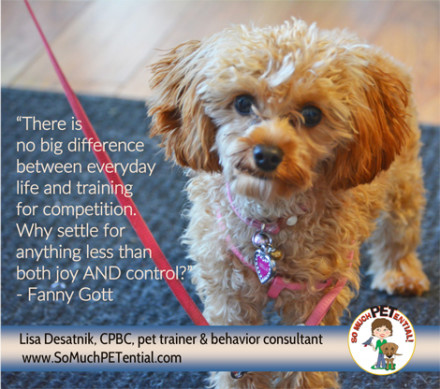This past weekend I attended a fun, two-day workshop on teaching self control by Swedish dog trainer (and border collie breeder) Fanny Gott at PosiDog in Columbus. She and her husband have a training school focusing on clicker training for dog sports.
 Fanny reminded us to teach dogs self control with choice rather than with lures, prompts and punishment. It is how you teach your dog to problem solve and to think through choices of behavior that lead to valued consequences (for your dog). It is also about you having fun with your pet and strengthening your relationship.
Fanny reminded us to teach dogs self control with choice rather than with lures, prompts and punishment. It is how you teach your dog to problem solve and to think through choices of behavior that lead to valued consequences (for your dog). It is also about you having fun with your pet and strengthening your relationship.
“There is no big difference between everyday life and training for competition,” Fanny told us. “Why settle for anything less than both joy AND control?”
In our workshop, there were about a dozen working dogs with a whole broad range of training experience from a german shepherd who was preparing for obedience competition to puppies who thought nothing of running at the end of their leash to jump on new people to a small dog who quivered and scanned the room and all of its scary newness.
Fun play and food (and, in the case of the people-loving puppies, the opportunity to run up to strangers) were the valued reinforcers for them. A dog who is crazy about a ball was being taught that doing something else was the way to a favorite object. A dog who really wanted that piece of food in a bowl was being taught that the way to get a piece of food is to be able to walk by the bowl at his owner’s side. A dog who lay calmly on the ground was given the opportunity to get an awesome toy. A dog who had no interest in food when a favorite toy was within reach was being taught that it was the behavior of taking the offered treat that got him a game of tug.
While the lessons were very different, their similarity was in teaching dogs contingencies between behaviors and consequences – and in making the classroom fun. The reinforcers were consequences that the dog values. (I will write about increasing the value of reinforcers in a future post.)
The other similarity? These dogs were working! Make no mistake about it, they were absolutely exercising. In fact, even a border collie tired after about five minutes or so of a training session. It occurred to me how often people talk about taking their dog for a walk when they talk about exercise. Training your dog to focus on a lesson that involves both physical and mental control is exhausting. In fact, Fanny reminded us that after a short session, it is important to give dogs time to rest and to avoid another difficult training session right afterward.
Equally important, is that self control is something that must be practiced often and with consistency in order to strengthen. These are some tips Fanny gave for practicing.
- Look at everything happening in your training session. Ask yourself, is your dog showing self control or getting reinforcement for behaviors you do not want to see?
- Look at increasing your dog’s self control in everyday life. Really think about it. When are you being proactive vs reactive to your dog’s behavior? And how can you change that?
- Ask yourself, “how much are you managing your dog vs how often is your dog given a choice?”
Remember, this is about controlling access to reinforcers NOT controlling your dog.
What are some ways in which you have taught your dog self control? I’d love to hear.






